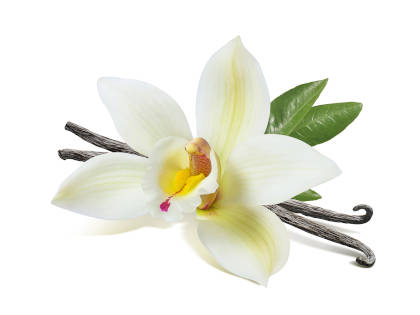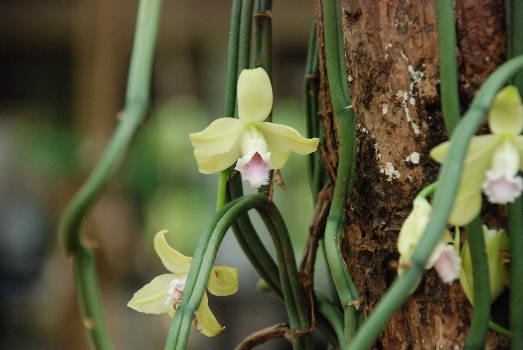If you have a sweet tooth, chances are you’re very familiar with the scent and flavor of vanilla (Vanilla species, especially V. planifolia). This spice actually comes from a type of orchid, which produces long, brown pods full of tiny seeds.
These orchids are native to Mesoamerica, though they are now grown in tropical climates around the world.
Because of their origins and horticultural needs, they are a latecomer to European-based witchcraft traditions. Nonetheless, they have found a home there — especially in kitchen witchery.
Magical Properties of Vanilla
Vanilla is a compelling herb, which means that it helps when used in recipes intended to assert your will over a person or situation.
As a love herb, vanilla acts on a very physical level. It yields a result that’s closer to seduction than pure love. Interestingly, it’s also sometimes used in spells for friendship.
When used in incense, vanilla helps boost feelings of comfort and inner peace. It’s sometimes used to improve mental focus while studying or doing work that requires concentration.
Vanilla is also used in money recipes.
See also: Check out Vanilla beans, extracts, and pastes here, and Vanilla essential oils here.
Benefits & Uses
In aromatherapy, vanilla produces a calming effect. In one study, premature babies who smelled vanilla before and during a blood test appeared calmer. The scent also correlated with less crying in newborn infants.

Since vanilla has a dessert-like scent and flavor, using it in recipes can slightly lessen the need for added sugar. Vanilla has a lower glycemic impact than refined sugar, so it may be helpful for those wishing to follow a low glycemic diet.
Possible Risks & Side Effects
If you are allergic to vanilla, using it can trigger symptoms ranging from rashes, to stomach upset, to trouble breathing, all the way to anaphylaxis. If you are or think you may be allergic to this spice, please substitute another herb in its place.
Vanilla is perfectly safe for most people when consumed in the amount you’d use to flavor food. Most of its medicinal uses are aromatherapeutic, so the odds of consuming too much vanilla are pretty low.
Skin contact with vanilla can cause dermatitis.
It can also cause headache and insomnia, but this is mostly seen in people who manufacture vanilla extract or otherwise handle very large amounts of vanilla.
Like many popular spices, vanilla has a toxic counterpart. Some vanilla extracts (particularly those manufactured in Mexico) may contain extracts from the similar-tasting tonka bean.
Tonka beans contain a significant amount of coumarin, which is a naturally-occurring compound that has been linked to cancer, liver damage, and impaired congitive development.
Short term side effects can include nausea, blurred vision, dizziness, and loss of appetite. It should be noted that many common herbs and spices contain coumarin, like cassia cinnamon, and all should be used only in limited amounts.
History & Folklore
According to legend, there was a time when there was no vanilla. In the city of Papantla, Tenitzli and his wife were blessed with a beautiful daughter. She was so beautiful, they didn’t want to give her away in marriage to a regular man — no one could possibly be good enough.
Instead, they dedicated her to Tonoacayohua, the Goddess of crops. There, their daughter, Princess Tzacopontziza, dedicated her life to serving at the temple.
One day, a young prince named Zkatan-Oxga saw her retrieving flowers to make an offering to the goddess. He was so overcome with desire, he swore to kidnap her and flee. The next day, he waited in the bushes for her. When she passed by, he leapt out, declared his love, and urged her to come with him.

The lovers fled, but their escape was not to be. Priests of another god caught them, and offered up their bodies as a sacrifice. On the spot where their blood was shed, the grass began to wither and die. In its place grew a lush bush with an emerald-green vine.
The vine seemed to twine around the bush in an embrace, and, before long, it produced beautiful flowers. These flowers gave way to slender pods, which gave a perfume sweeter than any incense.
Horticulturally, vanilla was nearly confined to its native range. It requires pollination, but not all pollinators are up to the task. Pollinators evolved alongside the plants they depend on for food, and vice versa, so trying to grow vanilla away from its native insect population meant that it could never bear fruit.
In 1841, a brilliant 12 year old boy named Edmond Albius who worked as a slave on the French-owned Réunion island discovered a way to pollinate vanilla by hand. This made worldwide vanilla production commercially viable. A French botanist attempted to steal this discovery, but Albius is recognized as the true inventor.
Getting Started With Vanilla
Vanilla isn’t really suitable for growing at home, unless you happen to have a hothouse or live in one of the countries in which it’s cultivated.
Even then, it’s best to buy plants rather than starting vanilla from seed. Plants take a long time to mature, and it can be from 3-5 years before they begin yielding pods.
If you’d like to get started with vanilla, one of the best ways is by making your own extract. You can do this in a magical context, or purely for culinary purposes.
All you’ll need is a clean, tall jar or bottle that can hold at least 12 vanilla beans, as many vanilla beans as it will hold, and a neutral, high-proof alcohol (like vodka).
To make the extract, fill the bottle or jar with beans, then pour in the alcohol. Allow the extract to infuse for at least a month, shaking daily.
If you plan to use this for magical purposes, you can visualize the extract filling with energy each time you shake it, begin the infusion process on the night of the dark moon, and place it in the light of the full moon when the time is right. This will fill it both with your intent, and with a full cycle of lunar energy.
To use the extract, just pour some of the liquid out of the bottle. You can also take out the vanilla pods, split them, and use the seeds inside for baking. This extract can even be kept going pretty much indefinitely simply by adding fresh beans and alcohol when needed.
Vanilla has entranced perfumers and bakers for centuries. With its sweet, seductive, calming fragrance and comforting flavor, it’s probably unsurprising that it has found its way into witchcraft.
If you enjoy vanilla, working with its pods in a magical context can give you a whole other dimension in which to appreciate it.
As an Amazon Associate, Terravara earns from qualifying purchases at no additional cost to readers.
